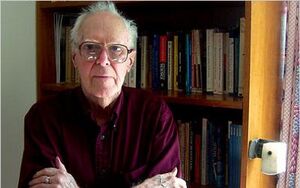
Martin Gardner.
Martin Gardner (October 21, 1914 - May 22, 2010) was an American writer best known for Mathematical Games, a long-running Scientific American column (1957-1981). Although he had no formal education in mathematics, Gardner had the ability to present sophisticated mathematical concepts in interesting and understandable ways. His writings helped popularize recreational mathematics.
Gardner was a prolific author, editor, and annotator, publishing more than 100 mostly non-fiction books on such diverse topics as magic, philosophy, science, and literature in addition to recreational mathematics. A fervent rationalist, he also helped launch the skepticism movement against pseudoscience with Fads and Fallacies in the Name of Science (1957) and later wrote a regular column for the Skeptical Inquirer (1983-2002).
Gardner was also one of the leading experts on Lewis Carroll. The Annotated Alice (1960), his annotated edition of Alice's Adventures in Wonderland and Through the Looking-Glass, is an international best-seller.
Biography[]

1932 photograph of Martin Gardenr from his high school yearbook.
Martin Gardner was born in Tulsa, Oklahoma in 1914. He developed his interests in magic, puzzles, and games at an early age, and began publishing magic tricks when he was only 15 years old. After graduating from the University of Chicago in 1936 with a degree in philosophy, Gardner briefly worked for a newspaper then in press relations. He then served for four years in the Navy during World War II before beginning his career as a freelance writer with the publication of several short stories in Esquire magazine.
A few years later, Gardner moved to New York City where he met and married Charlotte Greenwald, and spent the 1950s working as a contributing editor of Humpty Dumpty Magazine for children, writing poems and stories as well as devising paper-folding activities.
Gardner was also active in the local magic community. At a weekly gathering, one of the magicians introduced him to a hexaflexagon (a strip of paper folded to make a hexagon which, when pinched, reveals a hidden image). Fascinated, Gardner wrote an article about flexagons. He submitted it to Scientific American, and was immediately offered a monthly column. The flexagon article was published in the December 1956 issue, and the first Mathematical Games column appeared in the January 1957 issue. The column developed a large following and remained one of the most popular features of the magazine - introducing readers to such topics as M.C. Escher's artwork, Penrose tiles, and fractals - until Gardner's resignation in 1981.

Martin Gardner in 1979.
While writing his monthly column on recreational mathematics, Gardner also wrote and edited books in other fields that interested him. In 1960, he published an annotated edition of Lewis Carroll's Alice's Adventures in Wonderland and Through the Looking-Glass entitled The Annotated Alice which became by far his best seller. He published other annotated editions as well as his own fiction, The Flight of Peter Fromm (1973), during this period.
After retiring from Scientific American in order to devote more time to writing books, Gardner moved to North Carolina. In his busy semi-retirement, he expanded his interests to write on such topics as philosophy and theology. He also wrote a column for Skeptical Inquirer, the journal of the Committee for Skeptical Inquiry which he had co-founded earlier with Carl Sagan, Isaac Asimov, and others. The column, Notes of a Fringe-Watcher, debunked pseudoscience from 1983 to 2002.
After his wife's death in 2000, Gardner moved to Norman, Oklahoma to be with one of his sons. He continued to publish well into his 90s. Gardner died on May 22, 2010.
Selected works[]

Martin Gardner's signature.
Many of Gardner's books have been published in multiple revised editions. Only years of original publication are given below.
Scientific American collections
- The Scientific American Book of Mathematical Puzzles and Diversions (1959)
- The 2nd Scientific American Book of Mathematical Puzzles and Diversions (1961)
- New Mathematical Diversions from Scientific American (1966)
- The Unexpected Hanging and Other Mathematical Diversions (1969)
- Martin Gardner's Sixth Book of Mathematical Games from Scientific American (1971)
- Mathematical Carnival (1975)
- Mathematical Magic Show (1977)
- Mathematical Circus (1980)
- Wheels, Life, and Other Mathematical Amusements (1983)
- The Magic Number of Dr. Matrix (1985)
- Knotted Doughnuts and Other Mathematical Entertainments (1986)
- Time Travel and Other Mathematical Bewilderments (1988)
- Penrose Tiles and Trapdoor Ciphers (1989)
- Fractal Music, Hypercards, and More: Mathematical Recreations from Scientific American Magazine (1992)
- The Last Recreations: Hydras, Eggs, and Other Mathematical Mystifications (1997)
Science
- Logic Machines and Diagrams (1958)
- The Ambidextrous Universe (1964)
Pseudoscience
- In the Name of Science (1952, later editions re-titled Fads and Fallacies in the Name of Science)
- Did Adam and Eve Have Navels? (2000)
Magic
- Encyclopedia of Impromptu Magic (1978)
- Martin Gardner Presents (1993)
Fiction
- The Flight of Peter Fromm (1973)
- The No-Sided Professor: and Other Tales of Fantasy, Humor, Mystery, and Philosophy (1987)
- Visitors from Oz (1998)
Annotated editions
- The Annotated Alice (1960)
- The Annotated Hunting of the Snark (1962)
- The Annotated Ancient Mariner (1965)
- The Annotated Casey at the Bat (1967)
- The Annotated Innocence of Father Brown (1987)
- The Annotated Night Before Christmas (1991)
- The Annotated Thursday (1999)
